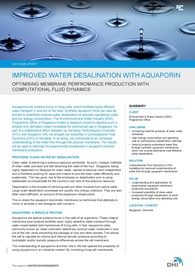|
|
|
 |
We conducted detailed Computational Fluid Dynamics (CFD) modelling to facilitate an increased understanding of the water flow through the aquaporin polymer membrane. The results will be used to optimise the experimental procedures in aquaporin polymer membrane production.
Clean water is becoming a precious resource worldwide. Singapore, being highly dependent on Malaysia for clean water, wishes to become more independent. The country is therefore pushing for ways and means to provide clean water efficiently and sustainably. This has given rise to the emphasis on desalination and re-using wastewater to compensate for the country’s own lack of this precious resource.
Aquaporins are proteins found in living cells, which facilitate highly efficient water transport in and out of the cells. Synthetic aquaporin films can also be formed to potentially improve water desalination at reduced operational costs and low energy consumption.
The Environment and Water Industry (EWI), Programme Office of Singapore funded a research project to develop such a product and ultimately make it available for commercial use in Singapore. As part of a collaborative effort between us, Singapore’s Nanyang Technological University (NTU) and Danish cleantech firm Aquaporin A/S, we brought our expertise in CFD to the table.
By conducting these modelling studies and analyses, we directly contributed to the process of improving aquaporin membranes. When these findings are successfully applied to commercial production, water reclamation by these state-of-the-art water purifying membranes could potentially be brought to every household worldwide.